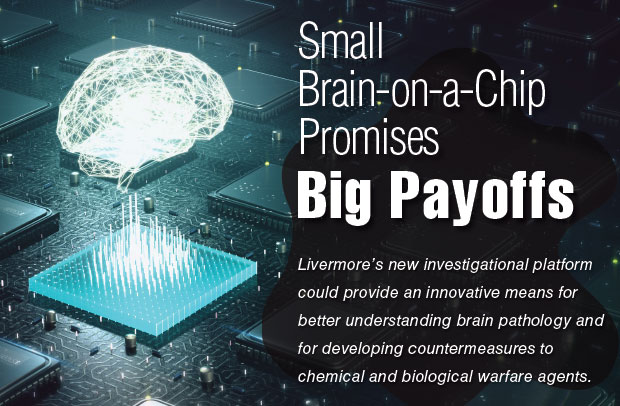Brain-on-a-chip devices create an interface between neuroscience and microfluidics by. Brain Brain Development on a Chip.
 Brain On A Chip A History Of Development And Future Perspective Biomicrofluidics Vol 13 No 5
Brain On A Chip A History Of Development And Future Perspective Biomicrofluidics Vol 13 No 5
Brain-on-a-Chip technology for disease modelling and fundamental brain research It is not far from reality to state that the brain is the most complex system in the universe.

Brain on a chip. The memristors are made up of a silver-copper alloy. Brain-on-a-chip devices span multiple levels of complexity in terms of cell culture methodology. Furthermore the essential key to adequately address drug development for human pathophysiological diseases of the nervous system such as Parkinsons or Alzheimers is to employ human induced pluripotent stem cell.
Brain-on-a-chip BoC concepts should consider three-dimensional 3D scaffolds to mimic the 3D nature of the human brain not accessible by conventional planar cell culturing. When brain cells are introduced onto the chip they can use the nanowire as. The scientists generated multiple types of brain cells from a single stem cell source.
These models or brain-on-a-chip BOC systems can make use of healthy or patient-derived cells to study the phenotype neuronal network formation and electrophysiological activity of these cells in a platform that allows for advanced read-out and a relevant in vivo-like microenvironment. Neurons are located on top and at the base of the structured electrodes. 3 modeling organ-level physiology and disease in vitroex vivo and 4 adding high precision and tunability of microfluidic devices.
Stem cell AI brain on a chip project aims to revolutionise computing power. A A multiple-organ system mimicking the conditions of the intestine liver and a brain tumor. The researchers used stem cell technology to generate brain tissue and blood vessels for.
But the engineers are trying to build a hardware-based neural network. The so-called brain-on-a-chip is essentially a wafer of semiconductors to which researchers affix a network of nanowires. The number of connections in our brain is estimated to be in the order of 100 trillion which is 1000 times more than the number of stars in our galaxy the Milky Way.
MITs new Brain on a Chip Most of these artificial neural networks are based on software. If they are successful these chips can have instant decision-making abilities without a working internet connection. Standard chips like that in our mobile and laptops have thousands of.
Blood-Brain Barrier on a Chip. State-of-the-art brain-on-a-chip devices. Stem cell AI -- brain on a chip project aims to revolutionize computing power January 29th 2021 SEM image of a primary rat neuronal culture grown on the 3D CMOS-MEA.
The researchers claim that this brain-on-a-chip is neural network hardwareas opposed to software artificial synapse networksthat can advance the development of portable intelligence systems. A brain or a spine and e. Brain-machine interfaces BMIs are devices that enable direct communicationtranslation between biological neuronal networks eg.
MIT engineers have designed a brain-on-a-chip smaller than a piece of confetti that is made from tens of thousands of artificial brain synapses known as memristors silicon-based components that mimic the information-transmitting synapses in the human brain. Revolutionary Neu-ChiP project will see scientists use human brain stem cells on microchips to push the boundaries of artificial intelligence AI Harnessing the unrivalled power and adaptability of the human brain the technology could supersede existing electronics. 1 improving culture viability.
The system biomimetically conditions drugs prior to exposure to glioma for improved drug screening Jie et al 2017. Zehntausende künstliche Synapsen im Einsatz. The recent development of brain-on-a-chip is an effort to mimic those structural and functional aspects of brain tissue within a miniaturized engineered platform.
From this perspective we provide an overview of trace of brain-on-a-chip development especially in terms of complexity and high-contenthigh-throughput screening capabilities and future perspectives on more in vivo -like. Image used courtesy of Peng Lin MIT. 2 supporting high-throughput screening.
Wissenschaftler am MIT haben es geschafft die neuronalen Strukturen des Gehirns wesentlich besser in einem Chip abzubilden als bisher. 2018 Curr Pharm Des Brain-on-a-chip Devices for Drug Screening and Disease Modeling Applications This review discusses the current strategies to make brain-on-chip devices their role in the study of the healthy and diseased brain and their limitations and future perspectives. Scientists will use.
MIT engineers have designed a brain-on-a-chip smaller than a piece of confetti made from tens of thousands of artificial synapses known as.
Halaman
T‑Mobile Newsroom
Labels
-
Eye catching graphics and UI. Staring at pregnancy tests day after day to the point where you might even be seeing an imaginary second line...
-
Its a must read for youDisability is not inability so goes a famous saying. He has formed an international non-profit organization Life Wit...
-
Tres personas han muerto aquí durante las últimas horas en diferentes circunstancias. Acepto el uso de cookies Más información. Resumen N...
-
Mittelschwerer Stoff 145 gm² 42 oz einfarbige T-Shirts aus 100 Baumwolle graumelierte aus 90 Baumwolle 10 Polyester anthrazit melierte aus ...
-
They change color from greens to brown. On the kitchen sink was a Common Indian Tree Frog or Chunam Tree Frog Polypedates maculatus. Dnr ...
